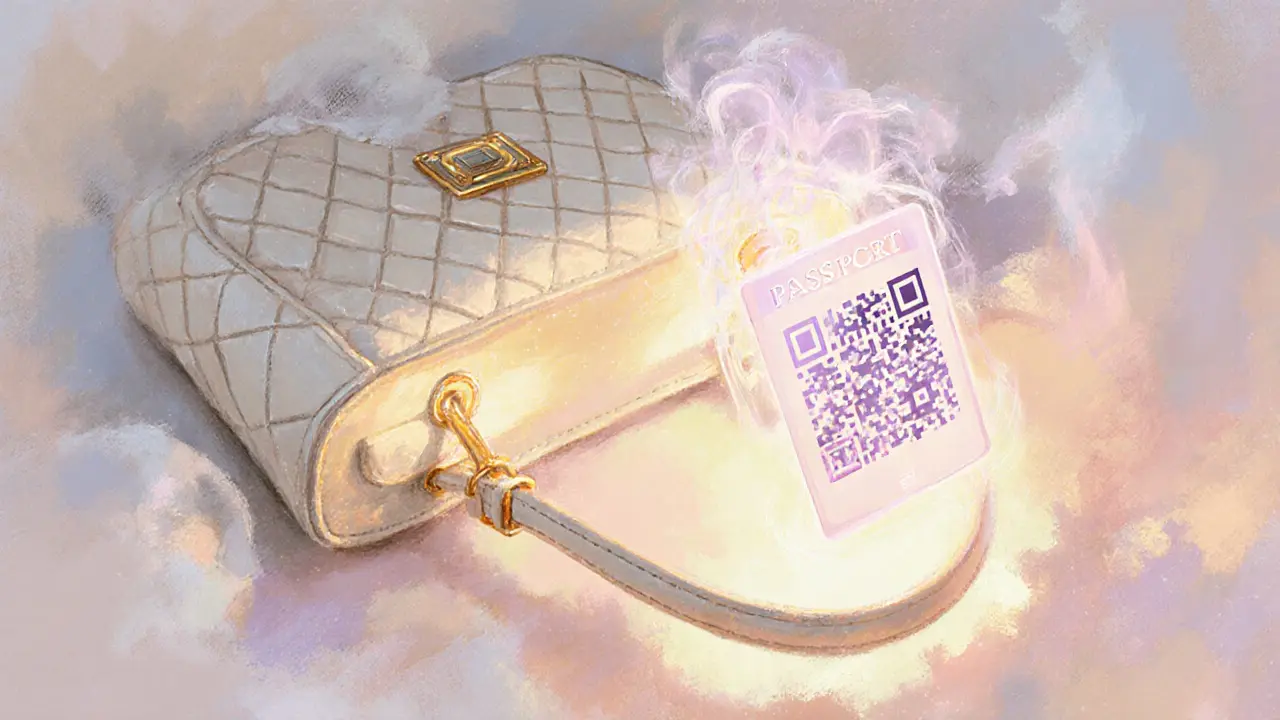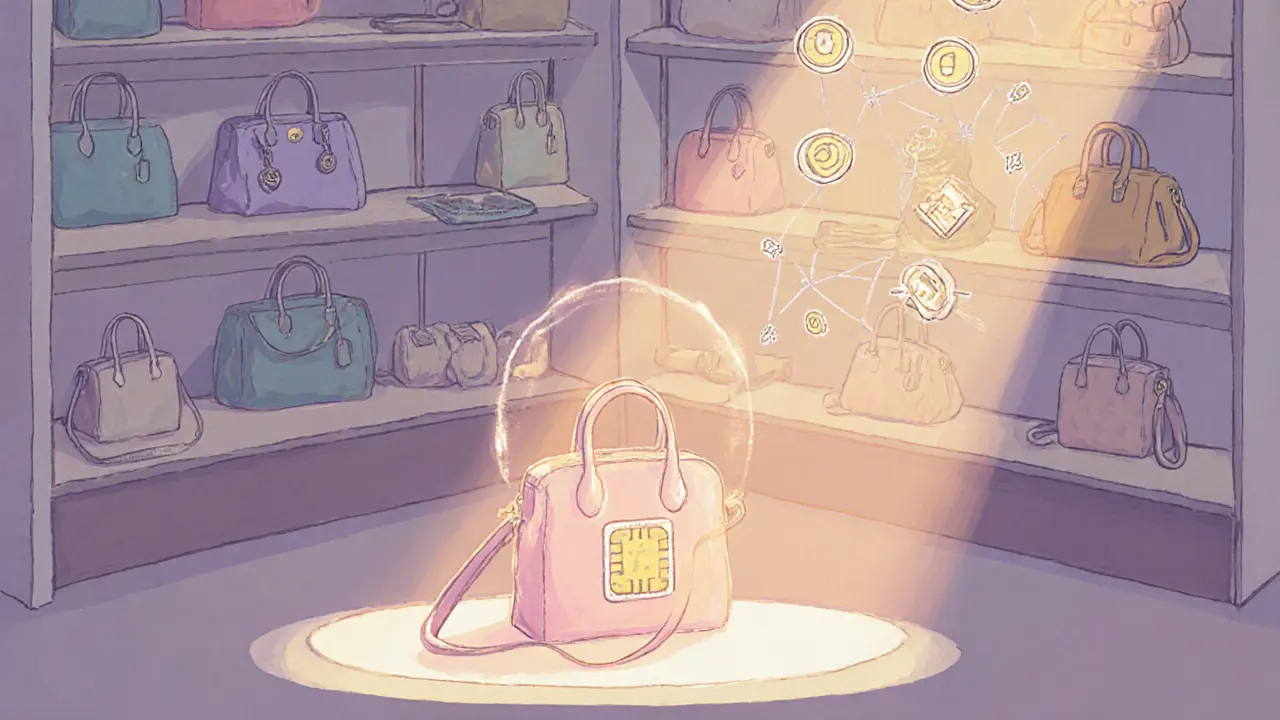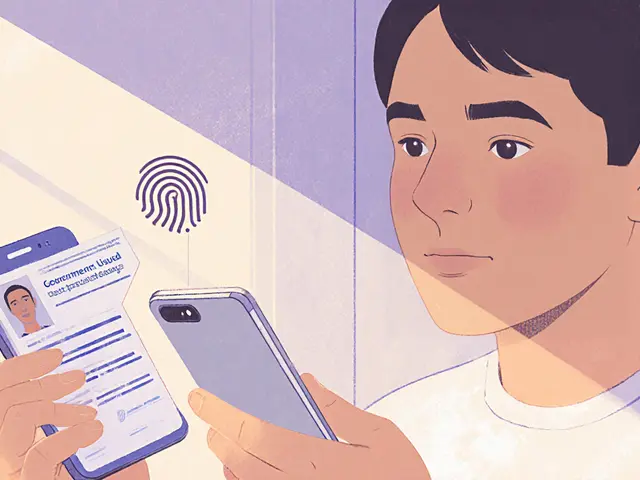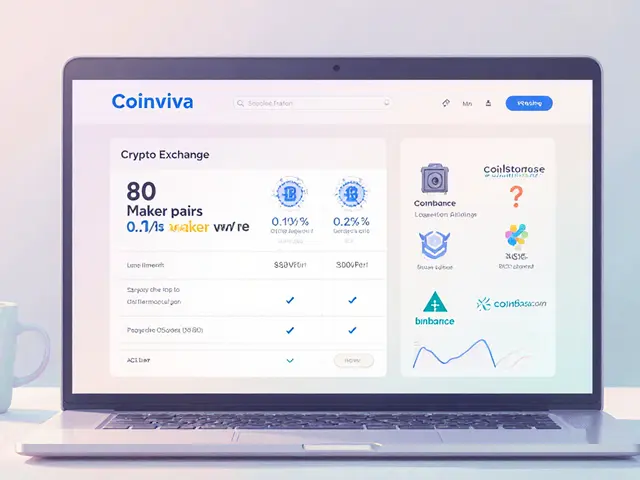How NFTs Are Revolutionizing Luxury Goods Authentication

Luxury Item Resale Value Calculator
Resale Value Calculator
Based on industry data showing NFT-verified luxury items sell for up to 29% more on resale platforms.
Enter the original price of your luxury item to see potential resale value increase with NFT authentication.
Counterfeit luxury goods cost the industry over $30 billion every year. Handbags, watches, and jewelry that look real but are fake flood the market - and buyers, even experienced ones, can’t always tell the difference. Traditional security tags, holograms, and paper certificates? They’re easy to copy. But now, a new system is changing everything: NFTs tied directly to physical luxury items. This isn’t science fiction. It’s happening right now, with brands like Louis Vuitton, Gucci, and Cartier using blockchain to prove their products are genuine.
What Exactly Is a Luxury NFT?
An NFT for a luxury item isn’t just a digital image. It’s a secure, tamper-proof digital passport that lives on a blockchain. Every time a handbag leaves the factory, a unique NFT is created and linked to its serial number. This NFT holds all the important details: where it was made, who owned it, when it was serviced, and even if it was repaired with original parts. When you scan a QR code or tap an NFC chip on the item with your phone, you instantly see this full history on your screen - verified by the blockchain.
Think of it like a car’s service record, but impossible to forge. No one can alter the data. No one can make a copy. And because it’s on a public ledger, anyone - a buyer, a reseller, or even a customs officer - can check it independently. This is the core advantage over old-school methods. Holograms can be printed. Paper certificates can be forged. But a blockchain record? It’s permanent.
How It Works: From Factory to Your Closet
The process starts at the production line. Luxury brands embed tiny NFC chips - smaller than a grain of rice - into the lining of a bag, the clasp of a watch, or the heel of a shoe. These chips aren’t just trackers; they’re secure hardware that stores encrypted data. When the item is finished, a unique NFT is minted on a blockchain (usually Ethereum or a private consortium like LVMH’s AURA). The NFT links to the chip’s unique ID and contains the item’s full history.
When you buy the item, you get both the physical product and access to its digital twin. Most brands use a companion app - like Arianee or the AURA app - to connect your phone to the NFT. You scan the tag, verify ownership, and the NFT is transferred into your digital wallet. If you later sell it, you can transfer the NFT to the new owner with a few taps. No paperwork. No doubt. The entire chain of custody is recorded forever.
Companies like SEALSQ and WISeKey have developed secure NFC chips that can’t be cloned. Even if someone steals the physical item, they can’t replicate the digital certificate. The chip and the NFT are cryptographically bound. If the chip is removed or tampered with, the NFT becomes invalid. That’s the kind of protection that makes counterfeiting nearly impossible.
Who’s Using This Tech - And Why
LVMH (parent company of Louis Vuitton, Dior, and Celine) launched the AURA blockchain platform in 2019 with Microsoft and ConsenSys. By 2023, they expanded it to include Prada and Cartier. That’s not a coincidence. These are brands with the highest counterfeit rates and the most valuable resale markets.
High-end watches are a big driver. A Rolex Submariner with full service history can sell for 40% more than one without. But verifying that history used to mean calling the brand, digging through archives, or trusting a third-party appraiser. Now, the NFT shows every service date, part replaced, and inspection report - all signed and stored on the blockchain.
Even fashion houses are jumping in. Burberry’s 2021 NFT collection for digital fashion proved consumers would pay for digital ownership. Now, they’re applying the same tech to physical items. Gucci and Dolce & Gabbana use NFTs to unlock exclusive events or digital collectibles tied to real products. It’s not just about authenticity - it’s about creating a richer, more interactive ownership experience.

Why Traditional Methods Fail
Before NFTs, brands relied on holograms, micro-printing, RFID tags, and serial numbers. But here’s the truth: 98% of counterfeit luxury goods successfully replicate these features, according to McKinsey’s 2021 report. Counterfeiters have labs that copy holograms down to the pixel. They print fake serial numbers. They even forge service stamps.
The real problem? Those methods don’t track ownership. A fake bag might have a real-looking serial number, but there’s no way to know if it was ever sold by an authorized retailer. With NFTs, you see the full journey: factory → authorized dealer → first owner → second owner → current owner. Every transfer is recorded. No gaps. No lies.
Plus, NFTs work on the secondary market. Platforms like The RealReal and Vestiaire Collective report a 29% increase in resale value and 37% fewer authentication disputes for NFT-verified items. Buyers pay more when they know it’s real. Sellers get paid faster. Everyone wins.
The Downsides - And Why They’re Not Dealbreakers
It’s not perfect. There are real challenges.
First, cost. Embedding NFC chips and building blockchain infrastructure isn’t cheap. Enterprise implementation can run between $500,000 and $2 million. That’s why smaller brands haven’t jumped in yet. But for high-margin items - think $2,000+ handbags or $10,000+ watches - the ROI is clear. Fewer returns, higher resale, less brand damage from fakes.
Second, user experience. Some apps require multiple downloads, complex logins, or crypto wallets. One 65-year-old woman on Trustpilot said she gave up trying to verify her Louis Vuitton bag because the process was too confusing. Brands are fixing this. Arianee and AURA now offer simplified web-based verification - no wallet needed. Just scan and view.
Third, energy use. Ethereum used to be criticized for high power consumption. But since its 2022 shift to proof-of-stake, energy use dropped by 99.95%. The environmental footprint of verifying a luxury bag’s NFT is now less than sending one email.
And what about older items? You can’t retrofit every vintage Chanel bag with an NFC chip. But companies like Arianee now offer blockchain-based digital watermarks - a cryptographic signature tied to photos and metadata of pre-NFT items. It’s not as strong as embedded chips, but it’s better than nothing.

What’s Next? The Future of Luxury and Blockchain
The market is growing fast. By 2027, the blockchain authentication sector for luxury goods is expected to hit $1.87 billion, growing at nearly 30% a year. Gartner predicts that by 2026, 30% of luxury brands will use blockchain authentication - up from less than 5% in 2022.
But the biggest shift won’t be just about stopping fakes. It’ll be about redefining ownership. Imagine buying a limited-edition Hermès bag and getting access to a private virtual showroom in the metaverse. Or owning a NFT-linked watch that unlocks a personalized digital art piece every time you wear it. Brands are already testing this. McLaren launched NFT passes for their limited-edition cars that grant digital perks. Why not for handbags?
Regulation is catching up too. The EU’s Digital Product Passport law, set to roll out by 2027, will require luxury goods sold in Europe to carry verifiable digital records - likely blockchain-based. That means even brands that haven’t adopted NFTs yet will be forced to.
And consolidation is coming. Right now, there are dozens of platforms: AURA, Arianee, WISeKey, Verix, and others. But Gartner says three will dominate by 2026. That’s good news for consumers. Imagine one app that verifies your Louis Vuitton, your Rolex, and your Cartier ring - all from the same place.
Is This For Everyone?
No. NFT authentication makes the most sense for high-value items with active resale markets. A $500 scarf? Probably not worth the cost. But a $5,000 handbag? Absolutely. A $15,000 watch? Essential.
It’s also not for everyone - yet. If you’re not tech-savvy, the process can feel overwhelming. But brands are simplifying it. Many now offer customer support lines that walk you through verification. Others embed the NFT data directly into product packaging via QR codes that open in a browser - no app needed.
The real win? Trust. For buyers, it means confidence. For sellers, it means faster sales. For brands, it means protecting their legacy. And for the industry, it means finally having a real weapon against the counterfeit tide.
Can I verify a luxury item’s NFT without a smartphone?
Most systems require a smartphone to scan an NFC tag or QR code. However, some brands offer web-based verification through a browser on a computer. You can upload photos of the item’s serial number and authentication code, and the system will cross-check it against the blockchain. But this is slower and less secure than using the app or NFC scan.
Do I need a crypto wallet to own a luxury NFT?
Not necessarily. Many luxury brands use managed wallets behind the scenes. You don’t need to understand blockchain or hold cryptocurrency. When you verify your item, the NFT is automatically assigned to your account in the brand’s app. You own it - but you don’t manage the private keys. This makes it accessible to non-tech users.
What happens if I lose my phone or delete the app?
Your NFT ownership is stored on the blockchain, not on your phone. If you lose your device or delete the app, you can log back in using your email or account credentials on a new device. The item’s digital passport remains intact. Brands like AURA and Arianee offer customer support to help you recover access - just like resetting a password for any online account.
Can counterfeiters hack the NFT system?
It’s extremely difficult. The NFT itself is secured by cryptography and stored on a decentralized blockchain. But counterfeiters could try to clone the NFC chip or fake the physical tag. That’s why brands use secure hardware like SEALSQ’s VaultIC155 chip, which is tamper-resistant and can’t be duplicated. The real vulnerability is user error - like trusting a fake website that mimics the brand’s verification portal. Always use the official app or website.
Are NFT-authenticated luxury items more expensive?
The retail price doesn’t usually increase because of the NFT. The cost of the chip and blockchain integration is absorbed by the brand. But because these items have verifiable histories, they often command higher resale prices - up to 29% more on platforms like The RealReal. So while you don’t pay more upfront, you get more value back when you sell.
Which luxury brands currently use NFT authentication?
Major players include LVMH brands (Louis Vuitton, Dior, Celine), Gucci, Prada, Cartier, Burberry, Dolce & Gabbana, and Chanel. Watchmakers like Rolex and Patek Philippe are testing similar systems. Some use the AURA consortium platform, others use Arianee or WISeKey. Check the brand’s official website or product packaging for verification instructions - if they mention blockchain or NFT, they’re using it.







This is actually a game changer for resale value. No more guessing if that bag is real or not.
Just scan and know.
I mean, sure, it’s cool tech, but why should I trust a big luxury brand to manage my digital ownership? They’ve screwed up customer service for decades. Now they want to lock me into their app ecosystem? Thanks, but no thanks.
Also, what if I just want to sell it to a friend? Do I need to log in to AURA first? This feels like overkill for a handbag.
Really cool idea but i think some people are gonna get lost in the app. My mom tried to verify her chanel bag and gave up after 20 mins. Brands need to make this idiot proof. Like, just show a green checkmark. No logins. No wallets. Just scan and know its real.
Also, the energy thing is a myth now-ethereum’s way better.
Let me get this straight-we’re now trusting blockchain to verify a $5,000 purse because some tech bros think decentralization is the answer to counterfeiting? Meanwhile, the real problem is that people are buying knockoffs because they can’t afford the real thing. This doesn’t fix inequality. It just makes the rich richer and the rest of us feel guilty for wanting something beautiful.
Also, who’s auditing these blockchain records? LVMH? Please.
The technical implementation here is solid. NFC chips paired with blockchain verification significantly reduce fraud, and the shift to proof-of-stake eliminates the environmental concerns that once plagued blockchain adoption.
What’s more impressive is how brands are handling user experience-no crypto wallet required, web-based verification, and customer support integration. This isn’t just tech for tech’s sake. It’s solving a real, expensive problem.
The only caveat is adoption speed among smaller brands, but with EU regulations coming in 2027, the market will force compliance. This is the future of luxury.
I appreciate how this is making luxury more transparent. It’s not just about stopping fakes-it’s about honoring the craftsmanship behind each piece.
People forget that a real Hermès bag takes 18 hours to make. That kind of care deserves a record that lasts.
And yes, it’s still early, but the fact that even non-tech users can verify without wallets? That’s thoughtful design.
Let’s not turn this into a debate about crypto. It’s about trust. And trust matters.
Okay but imagine this: you drop $20K on a watch, and the NFT gets hacked? Or worse-LVMH shuts down their app next year? What then? You’re holding a $20K paperweight with a dead digital passport.
This isn’t authentication. It’s a subscription service wrapped in blockchain hype.
And don’t even get me started on the fact that your NFT is basically a glorified QR code. If someone steals your phone, they don’t own the bag-but they can still scam someone else with the same scan. This is theater, not technology.
YASSS this is the future!!! 😍
Finally someone’s doing something about fakes!!
My cousin bought a fake Gucci bag last year and cried for a week. Now she’d just scan it and be like ‘NOPE’ and walk away.
Also, the metaverse perks? I’m already planning my virtual closet. 👜✨
Who else is buying their next bag just for the NFT unlock? I’m in!!
As someone from India, I’ve seen how fake luxury goods flood the market here. People buy them not because they want to deceive, but because they can’t afford the real thing.
This tech helps the brands, sure-but what about the buyers? Are we just making it harder for people to find affordable beauty?
Maybe the real win is when brands start offering smaller, NFT-verified items at lower prices. Not just for the rich.
Let’s not forget who we’re serving here.
I’ve been skeptical of NFTs for years, but this is the first use case that actually makes sense to me.
It’s not about speculation. It’s about legacy. A handbag that’s passed down with its full history? That’s meaningful.
And the fact that brands are making it accessible? That’s the quiet revolution here.
No crypto wallet? No problem. Just a QR code and a browser. That’s inclusion.
Wait. Let me get this straight. You’re telling me that a company like LVMH is now using blockchain to ‘prove’ authenticity… but they’re the same company that’s been hiding factory conditions and tax loopholes for decades?
What if the blockchain is just another layer of control? What if they’re tracking you through your phone every time you scan?
And what if they delete your NFT because you criticized them on social media?
This isn’t transparency. It’s surveillance with a pretty interface.
So now we’re letting corporations own our personal belongings digitally? That’s not ownership-that’s licensing. You don’t own the bag. You’re renting the digital proof from a multinational. And if they decide to shut down the server? Poof. Your ‘investment’ is gone.
And why should Americans care? Because this tech is being pushed by European brands while we’re stuck paying for their marketing?
Also, if you think this stops counterfeiting, you’re naive. The black market will adapt. Always does.
This is wild. I used to think NFTs were just monkey pics.
Now I’m looking at my dad’s old Rolex and thinking… wow, imagine if this thing had a digital history.
He got it in ’89. I bet we could trace every time he wore it to a job interview, a wedding, a funeral.
That’s not tech. That’s legacy.
Also, no wallet needed? YES PLEASE. I can barely log into my Netflix.
Love how this is making resale easier. I sold my old Dior bag last year and spent three weeks getting it authenticated. The buyer was nervous. I was nervous.
Now? Just a scan. Done.
Also, the fact that brands are finally doing something real about fakes? Long overdue.
And yes, it’s expensive to implement-but if you’re selling $10K items, the ROI is obvious.
Let’s not pretend this is perfect. But it’s a damn good step.
Did you know that the NFC chips used in these bags are made by a company that also supplies the U.S. military? That’s not a coincidence.
They’re not just tracking your purse-they’re building a database of your purchasing habits.
And guess who owns that data? Not you. Not even the brand. The infrastructure provider.
This isn’t authentication. It’s data harvesting dressed up as innovation.
Next thing you know, your luxury bag will be tied to your credit score.
And you’ll thank them for it.
I live in South Africa and we have so many fake bags here it’s crazy. I used to buy them because they looked good and I couldn’t afford the real thing.
But now I see this tech and I think… maybe one day I can buy the real one and know it’s safe.
It’s not about being rich. It’s about being proud of what you own.
And if this helps even one person feel that pride? Worth it.
My sister just bought a vintage Chanel and the seller said it had a ‘digital certificate’
I was like ‘what?’
Turns out it’s an NFT linked to the original receipt.
She cried. I cried.
It’s not about the money. It’s about the story.
And now the story can’t be erased.
While I appreciate the innovation, I must express some concern regarding the potential for systemic exclusion. Not everyone has access to smartphones, reliable internet, or digital literacy, particularly among aging populations and underserved communities.
Moreover, the reliance on proprietary platforms-AURA, Arianee, etc.-creates a fragmented ecosystem that may ultimately hinder interoperability and consumer autonomy.
Furthermore, the implicit assumption that blockchain inherently equates to trust is philosophically problematic; trust must be earned, not algorithmically enforced.
And while energy consumption is no longer a concern post-Proof-of-Stake, the environmental cost of producing and disposing of embedded NFC hardware remains unaddressed.
Thus, while the intent is commendable, the implementation requires greater ethical foresight and inclusive design.
It’s funny how we’re all so excited about blockchain solving a problem that’s really about desire and class.
People don’t buy luxury because they need it. They buy it because they want to belong.
And now we’re giving them a digital badge to prove they belong.
But what if the badge is fake? Or what if the system goes down?
What if the real luxury was never the bag, but the act of waiting, saving, dreaming?
Now we’ve turned aspiration into a QR code.
And I’m not sure that’s progress.
Or maybe it is.
I don’t know anymore.
So we’re using blockchain to verify a $5K purse? That’s rich. Meanwhile, the same companies are outsourcing labor to sweatshops and dodging taxes. This isn’t innovation-it’s virtue signaling wrapped in tech jargon.
And don’t even get me started on the ‘metaverse perks’-that’s just another way to extract more money from people who already paid $5K for a bag.
Also, typo-prone? I’m not even gonna fix the grammar in this comment because the whole system is a scam.
Back home in India, my uncle runs a small shop selling replica bags. He’s not a bad guy-he’s just trying to feed his family. This tech might stop fakes, but what about the people who make them?
Brands talk about ‘protecting legacy’ but never mention the artisans who copy their designs because they have no other way to survive.
Maybe the real solution isn’t blockchain-it’s fair wages and access.
But hey, at least my cousin can now scan his fake Gucci and feel a little less guilty.
Progress, I guess.
They’re using blockchain to track your bag… but who’s tracking the blockchain?
What if the government mandates a backdoor? What if China hacks the AURA network?
What if this becomes a tool for mass surveillance?
One day, you’ll be walking down the street and a drone will beep: ‘UNAUTHORIZED BAG DETECTED. OWNER FLAGGED.’
This isn’t authentication. It’s the beginning of the luxury police state.
And you’re all just scanning away like sheep.